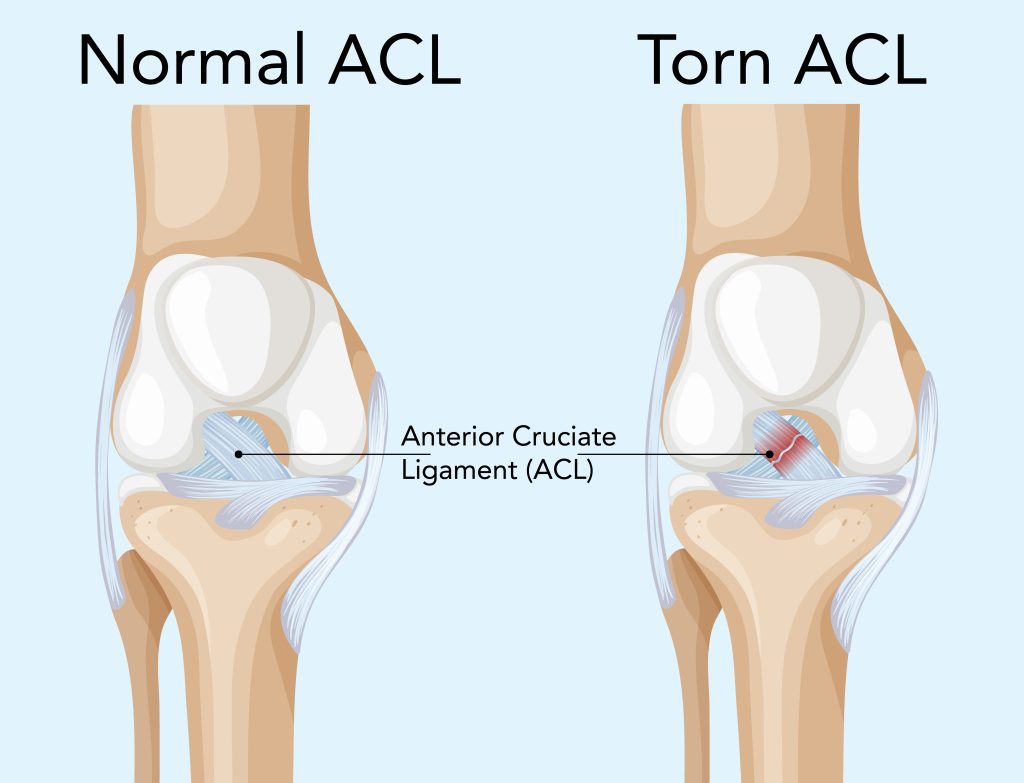What Is an ACL Tear?
The anterior cruciate ligament (ACL) is one of the four key ligaments in the knee that help stabilize the joint. Located in the center of the knee, it connects the femur (thigh bone) to the tibia (shin bone), playing a critical role in preventing the tibia from sliding forward relative to the femur. The ACL also assists in maintaining rotational stability during pivoting movements.
An ACL tear occurs when the ligament is stretched or torn beyond its structural limit, often resulting in a partial or complete rupture. These injuries are especially common in athletes and physically active individuals.
How Do ACL Tears Happen?
Contrary to popular belief, most ACL tears are not caused by direct collisions or contact. In fact, about 70–80% occur through non-contact mechanisms, typically during movements like:
-
Rapid deceleration
-
Sudden changes in direction
-
Pivoting or twisting
-
Landing awkwardly from a jump
These injuries are frequently seen in sports such as soccer, football, basketball, skiing, volleyball, and gymnastics. Female athletes have a higher risk—studies suggest up to three to five times more likely—due to a combination of anatomical, hormonal, and biomechanical factors.
Common Symptoms of an ACL Tear
Individuals who tear their ACL often describe a distinct “popping” sound or sensation at the time of injury, followed by:
-
Sudden, intense pain
-
Rapid swelling within hours
-
Difficulty bearing weight or walking
-
Instability or “giving way” of the knee
-
Loss of full range of motion
-
Inability to continue athletic activity
Prompt evaluation and imaging (usually MRI) are essential to confirm the diagnosis and assess any related injuries to the meniscus, cartilage, or other ligaments.
Can ACL Tears Be Prevented?
While no injury is 100% preventable, structured neuromuscular training programs can significantly reduce ACL injury risk. These programs focus on:
-
Enhancing strength and coordination of the hips, quads, hamstrings, and core
-
Teaching proper landing mechanics and pivot techniques
-
Improving proprioception and joint awareness
-
Encouraging safer movement patterns during sports
At Kerlan Jobe Institute, we emphasize whole-body biomechanics and long-term injury prevention—not just treatment of the torn ACL.
ACL Re-Injury: Understanding the Risks
After an initial ACL injury, the risk of a second tear—either in the repaired knee or the opposite one—is significantly increased, especially within the first two years post-surgery.
Factors that influence re-injury risk include:
-
Graft placement and surgical technique
-
Returning to sport too early
-
Incomplete rehabilitation
-
Failure to address associated injuries (e.g., meniscus, collateral ligaments)
-
Biomechanical imbalances
-
Lack of psychological readiness
Our team of knee specialists performs a high volume of successful ACL reconstructions annually and takes a comprehensive approach to reduce re-injury risk, including return-to-play testing, bracing (if appropriate), and long-term strength programming.
Treatment Options for ACL Tears
Treatment depends on the severity of the tear, patient age, activity level, and associated damage.
Non-Surgical Management:
Partial ACL tears or tears in less active individuals may be managed with:
-
Physical therapy
-
Bracing
-
Activity modification
However, most complete tears in active patients require surgery for full joint stability.
Surgical Reconstruction:
ACL reconstruction involves replacing the torn ligament with a graft, commonly from:
-
The patient’s own hamstring or patellar tendon (autograft)
-
A donor tendon (allograft)
Our surgeons at Kerlan Jobe Institute use advanced arthroscopic techniques and individualized graft selection to restore knee function with precision.
Recovery Timeline After ACL Surgery
Recovery is a gradual, multi-phase process. Here’s what patients can expect:
-
Days 1–5: Rest, swelling control, and light movement
-
Weeks 1–6: Begin physical therapy with focus on range of motion and gentle strength
-
Weeks 6–12: Weight-bearing exercises and foundational strengthening
-
Months 3–6: Functional training, agility, and sports-specific conditioning
-
Months 6–9+: Return-to-sport testing and gradual reintegration to high-impact activities
Return to full sports participation usually occurs around 6–9 months, but always depends on meeting objective strength, stability, and confidence benchmarks—not just time.
Why Choose Kerlan Jobe Institute for ACL Care?
At Kerlan Jobe Institute, we don’t just repair ACLs—we restore careers, confidence, and quality of life. Our fellowship-trained surgeons are nationally recognized in sports medicine and knee reconstruction. We combine surgical precision, cutting-edge rehab strategies, and personalized care plans to give every patient the best chance at a full recovery.

